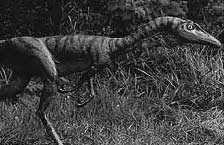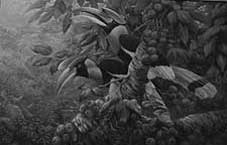| |
Questions?
darrylw[at]stanford.edu
Brochure
Science Art-Nature is a non-profit 501(c)(3) organization, your
donation is tax deductible.
Your support will encourage the production of Science Art that reminds us of our place in nature and our responsibiity to understand its limits.
.
Science Art-Nature
P.O. Box 18754
Palo Alto, CA 94309-8754
|
|
A small (29 pages) booklet, 13 Science Art Illustrations: Conservation Narratives, by Darryl Wheye is available through Amazon. It has three main aims: to call attention to species extinctions and efforts to avoid them described in the 2024 book, Before They Vanish (described below); to call attention to the book itself, for which the 13 illustrations were originally produced, and to represent a means of possible income for science artists not offered royalties on the sale of books containing their work. The booklet includes a forward by Paul R. Ehrlich. (January 18, 2025)

Jeffrey Brown, PBS senior arts correspondent hosted a segment on their arts and culture series, CANVAS. The topic? Art and science collide An enormous regional collaboration in Southern California called Pacific Standard Time (PST Art), which was initiated in 2011 is in its third iteration. It's this fall's largest collaborative effort in the US and features some 60 art institutions, including 20 presenting exhibitions on climate change. See SAN's calendar for a sample of events, and click on the image to link to the 7 minute PBS video.
(October 20, 2024).

The new book, ‘Before They Vanish’ addresses the crisis of species loss through the lens of conserving populations. Rob Jordan reports on this very important book co-authored by Stanford emeritus professor, Paul Ehrlich, one of Science Art-Nature's founding board members, Gerardo Ceballus and Rodolfo Dirzo, all members of the U.S. National Academy of Sciences. The book includes science art illustrations by Darryl Wheye, another Science Art-Nature found board members.
(September 17, 2024)

North America has lost nearly 3 billion birds in the last 50 years--almost 30 percent of its population. Science Art gives this staggering total a face. Harry Stevens provides an interactive article in the Washington Post (January 17, 2024).
 Science Art-Nature (SA-N)provides a PDF of its 11 x 17" poster for the 2019-2021 portion of the Challenges of Climate Change virtual exhibit, including captions and recognition for five entries in particular, a virtual exhibit Science Art-Nature (SA-N)provides a PDF of its 11 x 17" poster for the 2019-2021 portion of the Challenges of Climate Change virtual exhibit, including captions and recognition for five entries in particular, a virtual exhibit
 American Institute of Biological Sciences' (AIBS)
11th annual Faces of Biology Photo Contast encourages "scientists to communicate their research to a broader audience by bringing elements of art into science" in BioScience, vol. 70, issue 4, April 2020. American Institute of Biological Sciences' (AIBS)
11th annual Faces of Biology Photo Contast encourages "scientists to communicate their research to a broader audience by bringing elements of art into science" in BioScience, vol. 70, issue 4, April 2020.
Ecological Society of America editorial discusses "Science-telling through art" in Frontiers in Ecology and the Environment, vol. 18, issue 3, April 2020.
 Founding Board Member and Chair Donald Kennedy dies from COVID-19 April 21, 2020. Founding Board Member and Chair Donald Kennedy dies from COVID-19 April 21, 2020.
 Science Art-Nature (SA-N) begins rolling out Challenges of Climate Change, a virtual exhibit in January 1, 2020. The exhibit rollout will continue as works are gradually added.
Science Art-Nature (SA-N) begins rolling out Challenges of Climate Change, a virtual exhibit in January 1, 2020. The exhibit rollout will continue as works are gradually added.
 World Environment Day (June 5) and Earth Day 2018 (April 22, 2018).
Click for an easy way to help reduce single-use plastics: reuse a household spray (detergent/cleaning) container. World Environment Day (June 5) and Earth Day 2018 (April 22, 2018).
Click for an easy way to help reduce single-use plastics: reuse a household spray (detergent/cleaning) container.
 Science Art-Nature Co-Founder, Tony Angell named Ranier Club's 2018 Laureate March 28. His monumental bronze raptor, Aspiration, with its four-foot wingspan, has been installed outside Seattle University's Lemieux Library. Science Art-Nature Co-Founder, Tony Angell named Ranier Club's 2018 Laureate March 28. His monumental bronze raptor, Aspiration, with its four-foot wingspan, has been installed outside Seattle University's Lemieux Library.
 A Science Art booklet became available February 22, 2018. You can find the 28-page booklet, Camouflage as Science Art on Amazon and Amazon Europe. Click for more info. A Science Art booklet became available February 22, 2018. You can find the 28-page booklet, Camouflage as Science Art on Amazon and Amazon Europe. Click for more info.
 A Science Art message to President Trump: Day One of his 2nd year. Drawing by Darryl Wheye calls attention to the EPA's decision to rollback the 1918 Migratory Bird Treaty Act. A Science Art message to President Trump: Day One of his 2nd year. Drawing by Darryl Wheye calls attention to the EPA's decision to rollback the 1918 Migratory Bird Treaty Act.
 A Science Art message to President Trump: Day One of his administration. Painting by Patricia Pepin calls attention to water quality; the caption links it to the Adminstration's agenda. A Science Art message to President Trump: Day One of his administration. Painting by Patricia Pepin calls attention to water quality; the caption links it to the Adminstration's agenda.
 An artist/scientist collaboration. Are there caterpillars on butterfly wings? Paul R. Ehrlich, (SA-N founding board member, 2009-2011) and Darryl Wheye (SA-N CEO) ask if the apparent resemblances between some butterfly larvae and elements on the wings of adults are coincidental or adaptive. An artist/scientist collaboration. Are there caterpillars on butterfly wings? Paul R. Ehrlich, (SA-N founding board member, 2009-2011) and Darryl Wheye (SA-N CEO) ask if the apparent resemblances between some butterfly larvae and elements on the wings of adults are coincidental or adaptive.
 Development of a hummingbird garden. Donald Kennedy, (SA-N founding board member, 2009-2014) and Darryl Wheye (SA-N CEO)in association with the placement of John James Audubon’s print of Anna’s Hummingbirds--and its Science Art caption--in Stanford University's Green Library. The Audubon print is part of Art at Exits: Seeing Stanford Species. (See 2, below). Development of a hummingbird garden. Donald Kennedy, (SA-N founding board member, 2009-2014) and Darryl Wheye (SA-N CEO)in association with the placement of John James Audubon’s print of Anna’s Hummingbirds--and its Science Art caption--in Stanford University's Green Library. The Audubon print is part of Art at Exits: Seeing Stanford Species. (See 2, below).
 Review: Annihilation of Nature: Human Extinction of Birds and Mammals. Gerardo Ceballos,
Anne H. Ehrlich (SA-N Affiliate) and Paul R. Ehrlich (SA-N founding board member, 2009-2011) Review: Annihilation of Nature: Human Extinction of Birds and Mammals. Gerardo Ceballos,
Anne H. Ehrlich (SA-N Affiliate) and Paul R. Ehrlich (SA-N founding board member, 2009-2011)
2. ON-GOING SPONSORED PROJECT:
 Art at Exits: Seeing Stanford Species. The exhibit--and its web coverage--includes 10 works by John James Audubon featuring birds found on Stanford's main campus. The Audubons are placed near 9 building exits opening toward areas the featured birds frequent. A digital display in a 10th building features species researchers are studying. Captions provide a science lens. Art at Exits: Seeing Stanford Species. The exhibit--and its web coverage--includes 10 works by John James Audubon featuring birds found on Stanford's main campus. The Audubons are placed near 9 building exits opening toward areas the featured birds frequent. A digital display in a 10th building features species researchers are studying. Captions provide a science lens.
3. PREVIOUS VIRTUAL SCIENCE ART EXHIBIT:
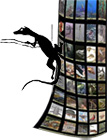 Windows on Evolution: An Artistic Celebration of Charles Darwin. It went live on Darwin Day--February 12, 2013. Link
to the caption for the Burgess Shale image, which was provided a preview Windows on Evolution: An Artistic Celebration of Charles Darwin. It went live on Darwin Day--February 12, 2013. Link
to the caption for the Burgess Shale image, which was provided a preview
4. EXAMPLE OF OPPORTUNITIES IN SCIENCE ART EDUCATION:
 Catherine Le and "Senior Reflections" Catherine Le and "Senior Reflections"
5. PREVIOUS VIRTUAL SCIENCE ART EXHIBIT:
 The selection of images in this exhibit was inspired by the AAAS 2011 Annual Meeting in Washington DC, Feb. 17-21, 2011.
This virtual exhibit is an example of how Science Art can expand the interest in and understanding of science discussed at science meeting and conferences. See our poster featuring art from this exhibit. The selection of images in this exhibit was inspired by the AAAS 2011 Annual Meeting in Washington DC, Feb. 17-21, 2011.
This virtual exhibit is an example of how Science Art can expand the interest in and understanding of science discussed at science meeting and conferences. See our poster featuring art from this exhibit.
6. BACKGROUND INFORMATION:
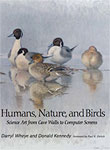 Humans, Nature, and Birds: Science Art from Cave Walls to Computer Screens, is a 2008 book by Darryl Wheye (SA-N CEO) and Donald Kennedy, (SA-N founding board member, 2009-2014) on the long history of images of nature that combine science and art. It was published with assistance from the Alfred P. Sloan Foundation's Public Understanding of Science and Technology Program. It received the 2008 ForeWord Magazine Book of the Year Award, in the Nature Category.
Humans, Nature, and Birds: Science Art from Cave Walls to Computer Screens, is a 2008 book by Darryl Wheye (SA-N CEO) and Donald Kennedy, (SA-N founding board member, 2009-2014) on the long history of images of nature that combine science and art. It was published with assistance from the Alfred P. Sloan Foundation's Public Understanding of Science and Technology Program. It received the 2008 ForeWord Magazine Book of the Year Award, in the Nature Category.
|
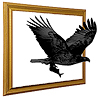 Science Art-Nature
Science Art-Nature Science Art-Nature
Science Art-Nature